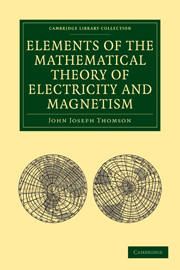Book contents
- Frontmatter
- PREFACE TO FIRST EDITION
- PREFACE TO THE SECOND EDITION
- PREFACE TO THE THIRD EDITION
- PREFACE TO THE FOURTH EDITION
- Contents
- CHAP. I General Principles of Electrostatics
- CHAP. II Lines of Force
- CHAP. III Capacity of Conductors. Condensers
- CHAP. IV Specific Inductive Capacity
- CHAP. V Electrical Images and Inversion
- CHAP. VI Magnetism
- CHAP. VII Terrestrial Magnetism
- CHAP. VIII Magnetic Induction
- CHAP. IX Electric Currents
- CHAP. X Magnetic Force due to Currents
- CHAP. XI Electromagnetic Induction
- CHAP. XII Electrical Units: Dimensions of Electrical Quantities
- CHAP. XIII Dielectric Currents and the Electromagnetic Theory of Light
- CHAP. XIV Thermoelectric Currents
- CHAP. XV The Properties of Moving Electric Charges
- INDEX
CHAP. VII - Terrestrial Magnetism
Published online by Cambridge University Press: 07 September 2010
- Frontmatter
- PREFACE TO FIRST EDITION
- PREFACE TO THE SECOND EDITION
- PREFACE TO THE THIRD EDITION
- PREFACE TO THE FOURTH EDITION
- Contents
- CHAP. I General Principles of Electrostatics
- CHAP. II Lines of Force
- CHAP. III Capacity of Conductors. Condensers
- CHAP. IV Specific Inductive Capacity
- CHAP. V Electrical Images and Inversion
- CHAP. VI Magnetism
- CHAP. VII Terrestrial Magnetism
- CHAP. VIII Magnetic Induction
- CHAP. IX Electric Currents
- CHAP. X Magnetic Force due to Currents
- CHAP. XI Electromagnetic Induction
- CHAP. XII Electrical Units: Dimensions of Electrical Quantities
- CHAP. XIII Dielectric Currents and the Electromagnetic Theory of Light
- CHAP. XIV Thermoelectric Currents
- CHAP. XV The Properties of Moving Electric Charges
- INDEX
Summary
140. The pointing of the compass in a definite direction was at first ascribed to the special attraction for iron possessed by the pole star. Gilbert, however, in his work De Magnete, published in 1600, pointed out that it showed that the earth was itself a magnet. Since Gilbert's time the study of Terrestrial Magnetism, i.e. the state of the earth's magnetic field, has received a great deal of attention and forms one of the most important, and undoubtedly one of the most mysterious departments of Physical Science.
141. To fix the state of the earth's magnetic field we require to know the magnetic force over the whole of the surface of the earth; the observations made at a number of magnetic observatories, scattered unfortunately somewhat irregularly at very wide intervals over the earth, give us an approximation to this.
To determine the magnitude and direction of the earth's magnetic force we require to know three things: the three usually taken are (1) the magnitude of the horizontal component of the earth's magnetic force, usually called the earth's horizontal force; (2) the angle which the direction of the horizontal force makes with the geographical meridian, this angle is called the declination; the vertical plane through the direction of the earth's horizontal force is called the magnetic meridian; (3) the dip, that is the complement of the angle which the axis of a magnet, suspended so as to be able to turn freely about an axle through its centre of gravity at right angles to the magnetic meridian, makes with the vertical.
- Type
- Chapter
- Information
- Elements of the Mathematical Theory of Electricity and Magnetism , pp. 232 - 245Publisher: Cambridge University PressPrint publication year: 2009First published in: 1895

